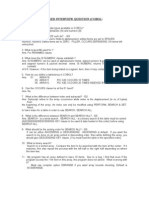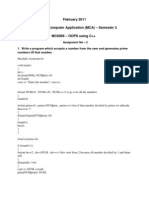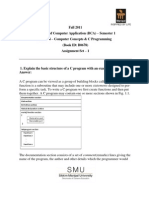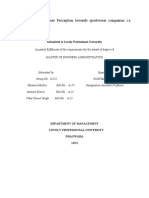Espresso
Espresso
Uploaded by
kbkkrCopyright:
Available Formats
Espresso
Espresso
Uploaded by
kbkkrOriginal Description:
Copyright
Available Formats
Share this document
Did you find this document useful?
Is this content inappropriate?
Copyright:
Available Formats
Espresso
Espresso
Uploaded by
kbkkrCopyright:
Available Formats
File Format: espresso
http://www.ecs.umass.edu/ece/labs/vlsicad/ece667...
ESPRESSO(5OCTTOOLS)
NAME
espresso - input le format for espresso(1OCTTOOLS)
DESCRIPTION
Espresso accepts as input a two-level description of a Boolean function.
This is described as a character matrix with keywords embedded in the
input to specify the size of the matrix and the logical format of the input
function. Programs exist to translate a set of equations into this format
(e.g., eqntott(1OCTTOOLS), bdsyn(1OCTTOOLS), eqntopla(1OCTTOOLS)). This manual page refers to Version 2.3 of Espresso.
Comments are allowed within the input by placing a pound sign (#) as the
rst character on a line. Comments and unrecognized keywords are passed
directly from the input le to standard output. Any white-space (blanks,
tabs, etc.), except when used as a delimiter in an embedded com- mand, is
ignored. It is generally assumed that the PLA is specied such that each
row of the PLA ts on a single line in the input le.
KEYWORDS
The following keywords are recognized by espresso. The list shows the
probable order of the keywords in a PLA description. [d] denotes a decimal
number and [s] denotes a text string. The minimum required set of
keywords is .i and .o for binary-valued functions, or .mv for multiplevalued functions.
.i [d]
Species the number of input variables.
.o [d]
Species the number of output functions.
.mv [num_var] [num_binary_var] [d1] . . . [dn]
Species the number of variables (num_var), the number of binary
variables (num_binary_var), and the size of each of the multiplevalued variables (d1 through dn).
.ilb [s1] [s2] . . . [sn]
Gives the names of the binary valued vari- ables. This must come after
.i and .o (or after .mv). There must be as many tokens fol- lowing the
keyword as there are input vari- ables.
.ob [s1] [s2] . . . [sn]
Gives the names of the output functions. This must come after .i and
1 of 9
Sunday 19 July 2015 01:19 AM
File Format: espresso
http://www.ecs.umass.edu/ece/labs/vlsicad/ece667...
.o (or after .mv). There must be as many tokens following the keyword
as there are output variables.
.label var=[d] [s1] [s2] ...
Species the names of the parts of a multi- ple-valued variable. This
must come after .mv. There must be as many tokens following the
keyword as there are parts for this vari- able. Note that the variables
are numbered starting from 0.
.type [s] Sets the logical interpretation of the character matrix as described below under "Logical Description of a PLA".
This keyword must come before any product terms. [s] is one of f, r,
fd, fr, dr, or fdr.
.phase [s] [s] is a string of as many 0's or 1's as there
are output functions. It species which polarity of each output
function should be used for the minimization (a 1 species that the
ON-set of the corresponding output func- tion should be used, and a 0
species that the OFF-set of the corresponding output func- tion
should be minimized).
.pair [d] Species the number of pairs of variables
which will be paired together using two-bit decoders. The rest of the
line contains pairs of numbers which specify the binary variables of
the PLA which will be paired together. The binary variables are
numbered starting with 0. The PLA will be reshaped so that any
unpaired binary variables occupy the leftmost part of the array, then
the paired multiple-valued columns, and nally any multiple-valued
vari- ables. If the labels have been specied using .ilb, then the
variable names may be used instead of the column number.
.symbolic [s0] [s1] . . . [sn] ; [t0] [t1] . . . [tm] ;
Species that the binary-valued variables named [s0] thru [sn] are to
be considered as a single multiple-valued variable. Variable [s0] is
considered the most signicant bit, [s1] the next most signicant, and
[sn] is the least signicant bit. This creates a variable with 2**n parts
corresponding to the decodes of the binary-valued variables. The
keywords [t0] thru [tm] provide the labels for each decode of [s0] thru
[sn]. ([t0] corre- sponds to a value of 00...00, [t1] is the value 00...01,
etc.). The binary-variables may be identied by column number, or by
variable name when .ilb is used. The binary- variables are removed
from the function after the multiple-valued variable is created.
.symbolic-output [s0] [s1] . . . [sn] ; [t0] [t1] . . . [tm] ;
Species that the output functions [s0] ... [sn] are to be considered as
2 of 9
Sunday 19 July 2015 01:19 AM
File Format: espresso
http://www.ecs.umass.edu/ece/labs/vlsicad/ece667...
a single symbolic output. This creates 2**n more output vari- ables
corresponding to the possible values of the outputs. The outputs may
be identied by number (starting from 0), or by variable name when
.ob is used. The outputs are removed from the function after the new
set of outputs is created.
.kiss
Sets up for a kiss-style minimization.
.p [d]
Species the number of product terms. The product terms (one per
line) follow immedi- ately after this keyword. Actually, this line is
ignored, and the ".e", ".end", or the end of the le indicate the end of
the input description.
.e (.end)
Optionally marks the end of the PLA descrip- tion.
LOGICAL DESCRIPTION OF A PLA
When we speak of the ON-set of a Boolean function, we mean those
minterms which imply the function value is a 1. Likewise, the OFF-set are
those terms which imply the function is a 0, and the DC-set (don't care set)
are those terms for which the function is unspecied. A function is
completely described by providing its ON-set, OFF-set and DC-set. Note
that all minterms lie in the union of the ON-set, OFF-set and DC-set, and
that the ON-set, OFF- set and DC-set share no minterms.
The purpose of the espresso minimization program is to nd a logically
equivalent set of product-terms to repre- sent the ON-set and optionally
minterms which lie in the DC-set, without containing any minterms of the
OFF-set.
A Boolean function can be described in one of the follow- ing ways:
1)
By providing the ON-set. In this case, espresso computes the OFF-set
as the complement of the ON- set and the DC-set is empty. This is
indicated with the keyword .type f in the input le.
2)
By providing the ON-set and DC-set. In this case, espresso computes
the OFF-set as the complement of the union of the ON-set and the
DC-set. If any minterm belongs to both the ON-set and DC-set, then it
is considered a don't care and may be removed from the ON-set
during the minimization process. This is indicated with the keyword
3 of 9
Sunday 19 July 2015 01:19 AM
File Format: espresso
http://www.ecs.umass.edu/ece/labs/vlsicad/ece667...
.type fd in the input le.
3)
By providing the ON-set and OFF-set. In this case, espresso computes
the DC-set as the complement of the union of the ON-set and the
OFF-set. It is an error for any minterm to belong to both the ON-set
and OFF-set. This error may not be detected during the minimization,
but it can be checked with the subprogram "-Dcheck" which will check
the consis- tency of a function. This is indicated with the keyword
.type fr in the input le.
4)
By providing the ON-set, OFF-set and DC-set. This is indicated with
the keyword .type fdr in the input le.
If at all possible, espresso should be given the DC-set (either implicitly or
explicitly) in order to improve the results of the minimization.
A term is represented by a "cube" which can be considered either a
compact representation of an algebraic product term which implies the
function value is a 1, or as a rep- resentation of a row in a PLA which
implements the term. A cube has an input part which corresponds to the
input plane of a PLA, and an output part which corresponds to the output
plane of a PLA (for the multiple-valued case, see below).
SYMBOLS IN THE PLA MATRIX AND THEIR INTERPRETATION
Each position in the input plane corresponds to an input variable where a 0
implies the corresponding input literal appears complemented in the
product term, a 1 implies the input literal appears uncomplemented in the
product term, and - implies the input literal does not appear in the product
term.
With type f, for each output, a 1 means this product term belongs to the
ON-set, and a 0 or - means this product term has no meaning for the value
of this function. This type corresponds to an actual PLA where only the
ON-set is actually implemented.
With type fd (the default), for each output, a 1 means this product term
belongs to the ON-set, a 0 means this product term has no meaning for the
value of this func- tion, and a - implies this product term belongs to the DCset.
With type fr, for each output, a 1 means this product term belongs to the
ON-set, a 0 means this product term belongs to the OFF-set, and a - means
this product term has no meaning for the value of this function.
4 of 9
Sunday 19 July 2015 01:19 AM
File Format: espresso
http://www.ecs.umass.edu/ece/labs/vlsicad/ece667...
With type fdr, for each output, a 1 means this product term belongs to the
ON-set, a 0 means this product term belongs to the OFF-set, a - means this
product term belongs to the DC-set, and a ~ implies this product term has
no meaning for the value of this function.
Note that regardless of the type of PLA, a ~ implies the product term has
no meaning for the value of this func- tion. 2 is allowed as a synonym for -,
4 is allowed for 1, and 3 is allowed for ~.
MULTIPLE-VALUED FUNCTIONS
Espresso will also minimize multiple-valued Boolean func- tions. There can
be an arbitrary number of multiple- valued variables, and each can be of a
dierent size. If there are also binary-valued variables, they should be
given as the rst variables on the line (for ease of description). Of course,
it is always possible to place them anywhere on the line as a two-valued
multiple-valued variable. The function size is described by the embedded
option .mv rather than .i and .o.
A multiple-output binary function with ni inputs and no outputs would be
specied as .mv ni+1 ni no. .mv cannot be used with either .i or .o - use
one or the other to specify the function size.
The binary variables are given as described above. Each of the multiplevalued variables are given as a bit-vector of 0 and 1 which have their usual
meaning for multiple- valued functions. The last multiple-valued variable
(also called the output) is interpreted as described above for the output (to
split the function into an ON-set, OFF-set and DC-set). A vertical bar | may
be used to separate the multiple-valued elds in the input le.
If the size of the multiple-valued eld is less than zero, than a symbolic
eld is interpreted from the input le. The absolute value of the size
species the maxi- mum number of unique symbolic labels which are
expected in this column. The symbolic labels are white-space delim- ited
strings of characters.
To perform a kiss-style encoding problem, the keyword .kiss should be
included in the le. The third to last variable on the input le must be the
symbolic "present state", and the second to last variable must be the "next
state". As always, the last variable is the output. The symbolic "next state"
will be hacked to be actually part of the output.
EXAMPLE #1
A two-bit adder which takes in two 2-bit operands and pro- duces a 3-bit
result can be described completely in minterms as:
5 of 9
Sunday 19 July 2015 01:19 AM
File Format: espresso
http://www.ecs.umass.edu/ece/labs/vlsicad/ece667...
# 2-bit by 2-bit binary adder (with no carry input)
.i 4
.o 3
0000 000
0001 001
0010 010
0011 011
0100 001
0101 010
0110 011
0111 100
1000 010
1001 011
1010 100
1011 101
1100 011
1101 100
1110 101
1111 110
It is also possible to specify some extra options, such as:
# 2-bit by 2-bit binary adder (with no carry input)
.i 4
.o 3
.ilb a1 a0 b1 b0
.ob s2 s1 s0
.pair 2 (a1 b1) (a0 b0)
.phase 011
0000 000
0001 001
0010 010
.
.
.
1111 110
.e
The option .pair indicates that the rst binary-valued variable should be
paired with the third binary-valued variable, and that the second variable
should be paired with the fourth variable. The function will then be
mapped into an equivalent multiple-valued minimization problem.
The option .phase indicates that the positive-phase should be used for the
second and third outputs, and that the negative phase should be used for
the rst output.
EXAMPLE #2
This example shows a description of a multiple-valued function with 5
binary variables and 3 multiple-valued variables (8 variables total) where
the multiple-valued variables have sizes of 4 27 and 10 (note that the last
6 of 9
Sunday 19 July 2015 01:19 AM
File Format: espresso
http://www.ecs.umass.edu/ece/labs/vlsicad/ece667...
multiple-valued variable is the "output" and also encodes the ON-set,
DC-set and OFF-set information).
.mv 8 5 4 27 10
.ilb in1 in2 in3 in4 in5
.label var=5 part1 part2 part3 part4
.label var=6 a b c d e f g h i j k l m n
o p q r s t u v w x y z a1
.label var=7 out1 out2 out3 out4 out5 out6
out7 out8 out9 out10
0-010|1000|100000000000000000000000000|0010000000
10-10|1000|010000000000000000000000000|1000000000
0-111|1000|001000000000000000000000000|0001000000
0-10-|1000|000100000000000000000000000|0001000000
00000|1000|000010000000000000000000000|1000000000
00010|1000|000001000000000000000000000|0010000000
01001|1000|000000100000000000000000000|0000000010
0101-|1000|000000010000000000000000000|0000000000
0-0-0|1000|000000001000000000000000000|1000000000
10000|1000|000000000100000000000000000|0000000000
11100|1000|000000000010000000000000000|0010000000
10-10|1000|000000000001000000000000000|0000000000
11111|1000|000000000000100000000000000|0010000000
.
.
.
11111|0001|000000000000000000000000001|0000000000
EXAMPLE #3
This example shows a description of a multiple-valued function setup for
kiss-style minimization. There are 5 binary variables, 2 symbolic variables
(the present-state and the next-state of the FSM) and the output (8
variables total).
.mv 8 5 -10 -10 6
.ilb io1 io0 init swr mack
.ob wait minit mrd sack mwr dli
.type fr
.kiss
--1-init0
110000
--1-init0
init0
110000
--0-init0
init1
110000
--00init1
init1
110000
--01init1
init2
110001
--0-init2
init4
110100
--01init4
init4
110100
--00init4
iowait
000000
0000iowait
iowait
000000
1000iowait
init1
110000
01000
iowait
read0
101000
11000
iowait
write0
100010
01001
iowait
rmack
100000
11001
iowait
wmack
100000
7 of 9
Sunday 19 July 2015 01:19 AM
File Format: espresso
http://www.ecs.umass.edu/ece/labs/vlsicad/ece667...
--01--0-0
--0-1
--0-0
--0-1
--0---0---0--
iowait
rmack
rmack
wmack
wmack
read0
read1
write0
init2
rmack
read0
wmack
write0
read1
iowait
iowait
110001
100000
101000
100000
100010
101001
000000
000000
22 August 1986 10 ESPRESSO(5OCTTOOLS) ESPRESSO(5OCTTOOLS)
EXAMPLE 4
This example shows the use of the .symbolic keyword to setup a multiplevalued minimization problem.
.i 15
.o 4
.ilb SeqActive<0> CacheOp<6> CacheOp<5> CacheOp<4>
CacheOp<3> CacheOp<2> CacheOp<1> CacheOp<0>
userKernel<0> Protection<1> Protection<0>
cacheState<1> cacheState<0> PageDirty<0>
WriteCycleIn<0>
.ob CacheBusy<0> dataMayBeValid<0> dataIsValid<0>
WriteCycleOut<0>
.symbolic CacheOp<6> CacheOp<5> CacheOp<4> CacheOp<3>
CacheOp<2> CacheOp<1> CacheOp<0> ;
FET NA PHY_FET PR32 PRE_FET PW32 RA32 RD32
RD64 RDCACHE RFO32 RFO64 TS32 WR32 WR64 WRCACHE ;
.symbolic Protection<1> Protection<0> ;
PROT_KRO_UNA PROT_KRW_UNA PROT_KRW_URO PROT_KRW_URW ;
.symbolic cacheState<1> cacheState<0> ;
CS_Invalid CS_OwnPrivate CS_OwnShared CS_UnOwned ;
.p 22
0000001--010110
0000001-1-00110
00001011-01011000010111-00110000--001--01-0000-10--0-1--0000-10-1--1--00000-0--0-1--00000-0-1--1--0000-10--0--1-0000-10-1---1-00000-0--0--1-00000-0-1---1----1------------1------------1------------1--------------
8 of 9
0001
0001
0100
0100
0100
0100
0100
0100
0100
0100
0100
0100
0100
1000
1000
1000
1000
Sunday 19 July 2015 01:19 AM
File Format: espresso
http://www.ecs.umass.edu/ece/labs/vlsicad/ece667...
-------0----------1--------------0--------------0---------------------1
.e
1000
1000
1000
1000
1110
See Also
espresso(1OCTTOOLS)
9 of 9
Sunday 19 July 2015 01:19 AM
You might also like
- The Rocc Doc V2: An Introduction To The Rocket Custom Coprocessor InterfaceDocument11 pagesThe Rocc Doc V2: An Introduction To The Rocket Custom Coprocessor Interfacekbkkr0% (1)
- CST To AST Tutorial: Fidel Viegas August 18, 2004Document16 pagesCST To AST Tutorial: Fidel Viegas August 18, 2004Fidel H. ViegasNo ratings yet
- Client Interview Question Bank (Mainframe)Document26 pagesClient Interview Question Bank (Mainframe)sairangad10No ratings yet
- Verilog Interview Questions With Answers!Document42 pagesVerilog Interview Questions With Answers!Vinod Lk95% (56)
- Training and Development Midterm ExamDocument20 pagesTraining and Development Midterm ExamSanti SeguinNo ratings yet
- Chap 6 - Departments, Agencies & Bureaus Involved in SME DevelopmentDocument18 pagesChap 6 - Departments, Agencies & Bureaus Involved in SME DevelopmentSheena Doria de Vera67% (3)
- Human Capacity Development PDFDocument33 pagesHuman Capacity Development PDFCu Ule40% (5)
- Assignment 3 PDFDocument9 pagesAssignment 3 PDFSohini RoyNo ratings yet
- Espresso TutorialDocument9 pagesEspresso TutorialsckidNo ratings yet
- Automation With PythonDocument15 pagesAutomation With PythonashishNo ratings yet
- # Frequently Asked Interview Question (Cobol)Document33 pages# Frequently Asked Interview Question (Cobol)Abhilash TiwariNo ratings yet
- Oracle PLSQL TutorialDocument33 pagesOracle PLSQL Tutorialdan629No ratings yet
- MY-BASIC Quick ReferenceDocument64 pagesMY-BASIC Quick ReferenceErnst-Georg ArpNo ratings yet
- Python FactsDocument8 pagesPython FactsJae JNo ratings yet
- Perl 5 Pocket ReferenceDocument74 pagesPerl 5 Pocket ReferenceRoshni ChopraNo ratings yet
- Python 2/5Document10 pagesPython 2/5AgnieszkaStyśNo ratings yet
- Module 2 AssemblersDocument24 pagesModule 2 AssemblerssrinivasNo ratings yet
- Compiler Construction Lecture Notes: Why Study Compilers?Document16 pagesCompiler Construction Lecture Notes: Why Study Compilers?jaseregNo ratings yet
- Preliminary APPLE 1 BASIC USERS MANUALDocument17 pagesPreliminary APPLE 1 BASIC USERS MANUALMarceloMGonçalvesNo ratings yet
- RTL Verilog DoulosDocument4 pagesRTL Verilog DoulosMiguel BrunoNo ratings yet
- February 2011 Master of Computer Application (MCA) - Semester 2 MC0066 - OOPS Using C++Document9 pagesFebruary 2011 Master of Computer Application (MCA) - Semester 2 MC0066 - OOPS Using C++Anil Singh BishtNo ratings yet
- Olivine DocumentationDocument9 pagesOlivine Documentationxicaf68562No ratings yet
- Embedded C Coding Standard V2Document5 pagesEmbedded C Coding Standard V2nsbaNo ratings yet
- Irredundant Standard Input Standard Output: Y F A B C D M DDocument4 pagesIrredundant Standard Input Standard Output: Y F A B C D M DRithi JantararatNo ratings yet
- Pmars Redcode 94Document6 pagesPmars Redcode 94japan.frigidly840No ratings yet
- Revision Tour of Python Class XIIDocument19 pagesRevision Tour of Python Class XIIhasanfazil953No ratings yet
- Syntax AnalyzerDocument38 pagesSyntax Analyzerporatble6No ratings yet
- PLC ST Example ST ProgramingDocument18 pagesPLC ST Example ST ProgramingStefan PascaNo ratings yet
- LDP UNIT - 3 AssignmentDocument24 pagesLDP UNIT - 3 Assignmentparth.dataxdataNo ratings yet
- PLSQL TutorialDocument77 pagesPLSQL TutorialMahesh BandaruNo ratings yet
- Ass12 ReferenceDocument7 pagesAss12 ReferenceRider rogueNo ratings yet
- Manual FullProf StudioDocument12 pagesManual FullProf StudioManuel Espinosa PesqueiraNo ratings yet
- Atari Basic Reference Guide (c061948 Rev.b) 1983Document12 pagesAtari Basic Reference Guide (c061948 Rev.b) 1983her234tzu100% (1)
- Eg: Int X 5, P &X, Q &PDocument11 pagesEg: Int X 5, P &X, Q &PAshish Rajendra MasihNo ratings yet
- Arduino-LED ProgrammingDocument65 pagesArduino-LED ProgrammingnitinsomanathanNo ratings yet
- Fall 2011 Bachelor of Computer Application (BCA) - Semester 1 BC0034 - Computer Concepts & C Programming (Book ID: B0678) Assignment Set - 1Document28 pagesFall 2011 Bachelor of Computer Application (BCA) - Semester 1 BC0034 - Computer Concepts & C Programming (Book ID: B0678) Assignment Set - 1Sintu MathurNo ratings yet
- Writing A Compiler With SableccDocument14 pagesWriting A Compiler With SableccFidel H. ViegasNo ratings yet
- Compiler Construction Lecture NotesDocument27 pagesCompiler Construction Lecture NotesFidelis GodwinNo ratings yet
- FortranDocument14 pagesFortranWasimBhatNo ratings yet
- Title:: Experiment - 02Document5 pagesTitle:: Experiment - 02MD Saifuzzaman SohanNo ratings yet
- JAVA Language FundamentalsDocument184 pagesJAVA Language FundamentalsSmita R. S.No ratings yet
- Basics of Perl: Advanced Unix Tools CS214 Spring 2002 Monday, March 11, 2002Document5 pagesBasics of Perl: Advanced Unix Tools CS214 Spring 2002 Monday, March 11, 2002sbtestoneNo ratings yet
- Db2 QuestionDocument31 pagesDb2 QuestionMohammed Ansarul Haq QureshiNo ratings yet
- Machine IndependentDocument10 pagesMachine Independentcoolbuddy_sasiNo ratings yet
- ZSM, A CP/M Z80 Assembler.Document15 pagesZSM, A CP/M Z80 Assembler.MiguelNo ratings yet
- MainframesDocument44 pagesMainframestalupurumNo ratings yet
- Cobol Interview QuestionsDocument45 pagesCobol Interview QuestionsParesh BhatiaNo ratings yet
- Loops and Branching: 3.1 The For LoopDocument19 pagesLoops and Branching: 3.1 The For LoopkarthiNo ratings yet
- App ADocument5 pagesApp Apolyu31469syyear3No ratings yet
- Differences Between Revised Oberon and Oberon: 1. The Loop and The While StatementsDocument2 pagesDifferences Between Revised Oberon and Oberon: 1. The Loop and The While Statementsmqt99311zwoho.comNo ratings yet
- PPL Lab Manual 2022-23Document40 pagesPPL Lab Manual 2022-2322405004nilayNo ratings yet
- Compiler Construction NotesDocument21 pagesCompiler Construction NotesvinayNo ratings yet
- Instructions 1209457942424462Document11 pagesInstructions 1209457942424462TranceNo ratings yet
- Data Types: CompilerDocument35 pagesData Types: CompilercsnivedhaNo ratings yet
- Python QB ct1Document19 pagesPython QB ct1mbhoomi23No ratings yet
- C Interview QuestionsDocument31 pagesC Interview QuestionsChandraShekarNo ratings yet
- Python: Advanced Guide to Programming Code with Python: Python Computer Programming, #4From EverandPython: Advanced Guide to Programming Code with Python: Python Computer Programming, #4No ratings yet
- Perl One-Liners: 130 Programs That Get Things DoneFrom EverandPerl One-Liners: 130 Programs That Get Things DoneRating: 4 out of 5 stars4/5 (3)
- Advanced SAS Interview Questions You'll Most Likely Be AskedFrom EverandAdvanced SAS Interview Questions You'll Most Likely Be AskedNo ratings yet
- Boom Template GithubDocument11 pagesBoom Template GithubkbkkrNo ratings yet
- The Berkeley Out-of-Order Machine (BOOM) : An Industry-Competitive, Synthesizable, Parameterized RISC-V ProcessorDocument5 pagesThe Berkeley Out-of-Order Machine (BOOM) : An Industry-Competitive, Synthesizable, Parameterized RISC-V ProcessorkbkkrNo ratings yet
- The Berkeley Out - of - Order Machine (Boom!) : An Open - Source Industry - Compeeeve, Synthesizable, Parameterized Risc - V ProcessorDocument45 pagesThe Berkeley Out - of - Order Machine (Boom!) : An Open - Source Industry - Compeeeve, Synthesizable, Parameterized Risc - V Processorkbkkr100% (1)
- Free and Open Instruction Sets & Other Stuff: Krste Asanović, Representing The ASPIRE LabDocument27 pagesFree and Open Instruction Sets & Other Stuff: Krste Asanović, Representing The ASPIRE LabkbkkrNo ratings yet
- Micro - Arch OpenpitonDocument51 pagesMicro - Arch OpenpitonkbkkrNo ratings yet
- File: /home/binod/documents/allfmca p/rocket-chip-master/README - MD Page 1 of 7Document7 pagesFile: /home/binod/documents/allfmca p/rocket-chip-master/README - MD Page 1 of 7kbkkrNo ratings yet
- Post-Silicon Fault Localisation Using MAX-SAT & Backbones: Georg WeissenbacherDocument25 pagesPost-Silicon Fault Localisation Using MAX-SAT & Backbones: Georg WeissenbacherkbkkrNo ratings yet
- Stealing Hyperparameters in Machine Learning: Binghui Wang and Neil Zhenqiang GongDocument30 pagesStealing Hyperparameters in Machine Learning: Binghui Wang and Neil Zhenqiang GongkbkkrNo ratings yet
- Christopher Celio, Krste Asanovic, David PalersonDocument35 pagesChristopher Celio, Krste Asanovic, David PalersonkbkkrNo ratings yet
- Wang CVDocument16 pagesWang CVkbkkrNo ratings yet
- Dataflow: Passing The TokenDocument42 pagesDataflow: Passing The TokenkbkkrNo ratings yet
- Assertion Based DebuggingDocument4 pagesAssertion Based DebuggingkbkkrNo ratings yet
- Unified Method To Detect Transistor Stuck-Open Faults & Transition Delay FaultsDocument18 pagesUnified Method To Detect Transistor Stuck-Open Faults & Transition Delay FaultskbkkrNo ratings yet
- 8 Tips For Waking Up Early & Conquering The Alarm ClockDocument9 pages8 Tips For Waking Up Early & Conquering The Alarm ClockkbkkrNo ratings yet
- Present On 2D CompactionDocument26 pagesPresent On 2D CompactionkbkkrNo ratings yet
- Tvlsi00 GuptaDocument11 pagesTvlsi00 GuptakbkkrNo ratings yet
- 4 Ways To Wake Up Early - WikihowDocument8 pages4 Ways To Wake Up Early - WikihowkbkkrNo ratings yet
- Transition Delay Fault Brad Hill ELEC 7250 April 13, 2006Document6 pagesTransition Delay Fault Brad Hill ELEC 7250 April 13, 2006kbkkrNo ratings yet
- ABC Command$Document20 pagesABC Command$kbkkrNo ratings yet
- Abc 1Document3 pagesAbc 1kbkkrNo ratings yet
- AltaLink C8130 Vs Konica Minolta C300i Face Off - 2Document27 pagesAltaLink C8130 Vs Konica Minolta C300i Face Off - 2paulo michaelNo ratings yet
- Entrepreneurship Development Among PWD in India MoDocument11 pagesEntrepreneurship Development Among PWD in India MoXia ChanNo ratings yet
- 9999 9999 263 en-GBDocument292 pages9999 9999 263 en-GBSalih PehlivanNo ratings yet
- Econ 471 Notes 1Document14 pagesEcon 471 Notes 1David Adeabah OsafoNo ratings yet
- Thermodynamics: An Engineering Approach, Third Edition (New Media Version)Document1 pageThermodynamics: An Engineering Approach, Third Edition (New Media Version)Raghib ShakeelNo ratings yet
- Finlatics Investment Banking Experience ProgramDocument3 pagesFinlatics Investment Banking Experience ProgramShalaka PhatakNo ratings yet
- Iwona Grzelak v. Julie Wainwright, Et AlDocument60 pagesIwona Grzelak v. Julie Wainwright, Et AlThe Fashion LawNo ratings yet
- Boeing 777Document16 pagesBoeing 777fabgourdon100% (1)
- CMM366A-ET enDocument15 pagesCMM366A-ET enManoel OliveiraNo ratings yet
- SME故障码ACDocument9 pagesSME故障码ACLei HeNo ratings yet
- Corporate Chapter of Legal Due Diligence ReportDocument13 pagesCorporate Chapter of Legal Due Diligence Reportricha.katiyar65No ratings yet
- PdfjoinerDocument48 pagesPdfjoinerAnisha SapraNo ratings yet
- FDR Go+ Product Specifications (S503-E030)Document40 pagesFDR Go+ Product Specifications (S503-E030)FibonacciNo ratings yet
- How To - Configure SSL VPN in CyberoamDocument9 pagesHow To - Configure SSL VPN in CyberoamPeter Mugogo KaranjaNo ratings yet
- Beam Analysis: LP LB LRDocument2 pagesBeam Analysis: LP LB LRLester John PrecillasNo ratings yet
- Marsen Catalog v6.0Document26 pagesMarsen Catalog v6.0seckin80100% (1)
- A Study On Consumer Perception Towards Sportswear Companies I.E. Nike & AdidasDocument37 pagesA Study On Consumer Perception Towards Sportswear Companies I.E. Nike & Adidassantosh0101No ratings yet
- LB1847Document17 pagesLB1847serlabtriesteNo ratings yet
- Updates On Food Labelling-PAFT Presentation-21 FebDocument73 pagesUpdates On Food Labelling-PAFT Presentation-21 Febcher28100% (2)
- Student Transfer PolicyDocument4 pagesStudent Transfer PolicyLasha ChakhvadzeNo ratings yet
- Lec2 Su20 10102022 121941pmDocument40 pagesLec2 Su20 10102022 121941pmMuneeb RaiNo ratings yet
- Digital Control System ModellingDocument28 pagesDigital Control System ModellingSonam AlviNo ratings yet
- Activity Worksheet: ExampleDocument6 pagesActivity Worksheet: ExampleNicole LagadoNo ratings yet
- FPS Manual de OperacionDocument131 pagesFPS Manual de OperacionEmmanuel Soberano HernandezNo ratings yet
- Presentation 22Document164 pagesPresentation 22shiraju649No ratings yet
- Error Free Liquid Flow Diverters For Calibration FDocument9 pagesError Free Liquid Flow Diverters For Calibration FMarco LatosaNo ratings yet
- RPMS Portfolio: For Proficient TeachersDocument37 pagesRPMS Portfolio: For Proficient TeachersJuliet Macaraeg AñesNo ratings yet














































































































